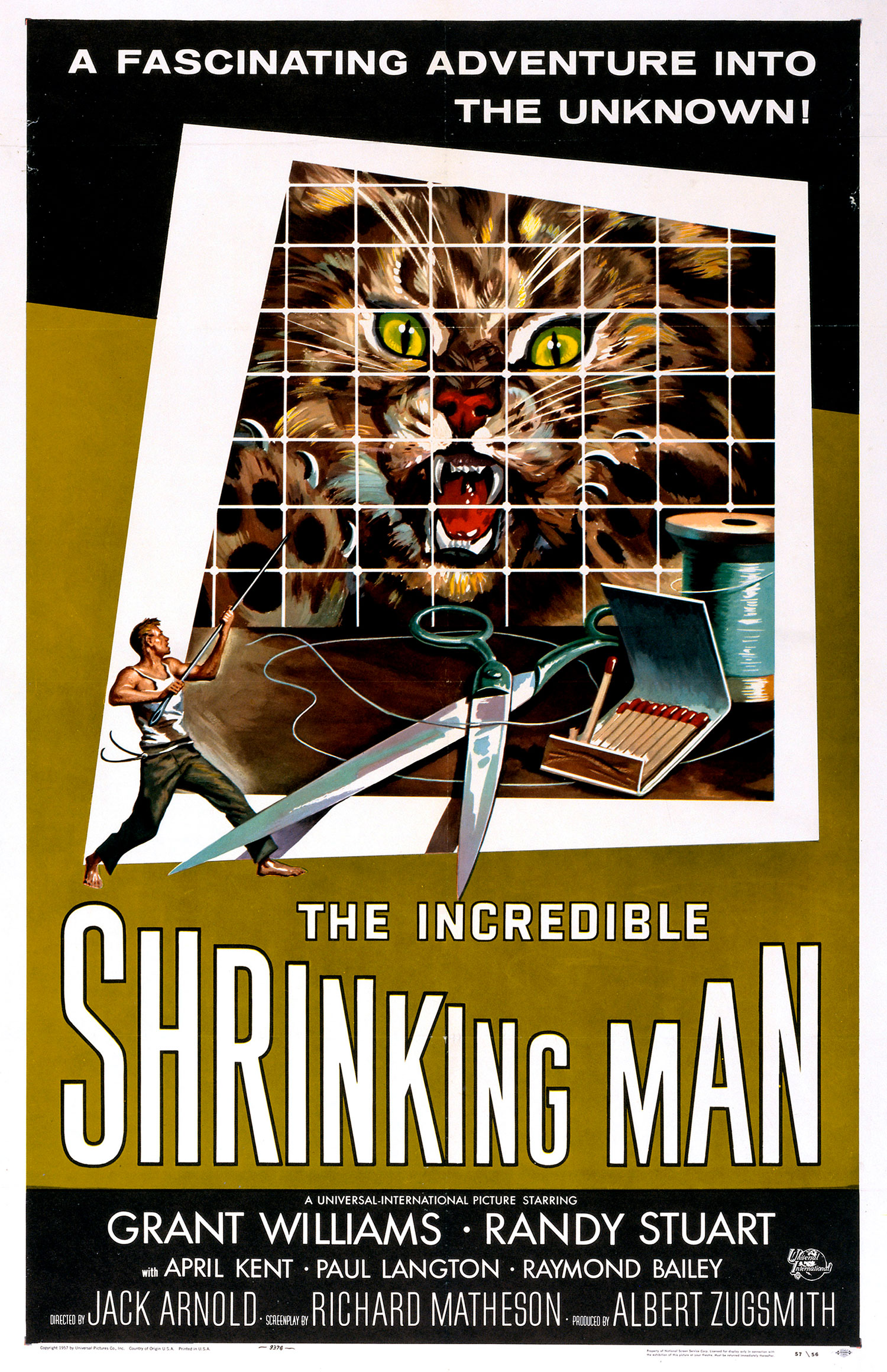I’m not sure if I like film titles that are such a literal description of the plot, but the title of this flick promises a shrinking man, and that’s just what viewers get.
The Incredible Shrinking Man was a hit back when it was released in 1957. It wasn’t a darling of the critics, but it has increased in reputation since, owing to some clever filmmaking from director Jack Arnold, and an above average screenplay by Richard Matheson, who was adapting his own novel.
Grant Williams plays Scott Carey, the man who shrinks incredibly. He and his wife, Louise (Randy Stuart), are out on the ocean in a small boat when Scott is exposed to a cloud of radioactive dust, presumably from a South Pacific nuclear test, while Louise is belowdecks. Nothing bad happens to Scott in the immediate aftermath, but many months later he discovers that his clothes no longer fit well. Louise dismisses it, at first, as weight loss, but that doesn’t explain why the sleeves of Scott’s shirts are now too long. Scott goes to the doctor, because if there is one thing in this universe that would make a stubborn American adult male go to the doctor, it’s the fear of losing height.
The doctor, played by veteran character actor William Schallert, confirms that Scott is indeed shrinking, making Scott the most baffling case in the annals of medicine.
Portraying Scott as decreasing in size is when Arnold uses effects and film trickery. Scott is decreasing in a uniform size, so his appearance doesn’t change at all. Arnold chose to film Scott’s plight mostly from Scott’s perspective, so the world appears bigger in every scene. Early on in the film, this meant outsized costumes for Scott, followed by  slightly larger versions of household items and furniture. Later, everyday objects were scaled up to gigantic proportions. In scenes where set design and props weren’t used, Scott’s image was superimposed into shots, and, unfortunately, these effects were not up to snuff. Many times, Scott’s body has transparency, the edges of the composite are ragged and visible, and Scott casts no shadow. Scott never integrates into these shots in a convincing fashion. The film is much better when it was filmed on a set with the outsized objects.
slightly larger versions of household items and furniture. Later, everyday objects were scaled up to gigantic proportions. In scenes where set design and props weren’t used, Scott’s image was superimposed into shots, and, unfortunately, these effects were not up to snuff. Many times, Scott’s body has transparency, the edges of the composite are ragged and visible, and Scott casts no shadow. Scott never integrates into these shots in a convincing fashion. The film is much better when it was filmed on a set with the outsized objects.
Eventually Scott shrinks down to such a size that the house he lives in becomes a threat, as all those tiny animals that we live with aren’t so tiny to Scott any longer.
Right smack in the middle, the film goes off the rails as Scott strikes up a friendship with a similarly-sized and proportioned carnival freak (April Kent), but then this sequence ends and it’s back to the regular movie. The intention here was Scott’s growth as a character. He found someone just as small as he, and was learning acceptance of his condition, but the whole thing is so ham-handed, and ends so abruptly, that I wish Arnold and Matheson had found another way to explore Scott going through the five stages.
The film climaxes in the basement, where Scott wound up after a confrontation with the family cat. This final act is a bit Tarzan, and a bit Robinson Crusoe. The basement is so large from Scott’s perspective that it is a strange new land, fraught with new challenges. I won’t spoil any more of the film, but it all leads to an ending that, apparently, audiences of the time were less than thrilled with. But, it was the right ending, even if Matheson’s prose got a little carried away.
Williams was a fine choice to play Scott Carey. His performance wasn’t spectacular or award-worthy, but it was a difficult role. Williams had to carry the majority of the film on his back, and then all of it, once his character got too small for normal human interactions. This film had such an outlandish premise that it was very important that the main character was believable. Williams delivered just the performance this film needed.
The plot and the tension of this film are holding up well, over a half-century since its release. Just the idea that something like this could happen to a person (it cannot) was enough to raise this film’s tension. Having the least capacity for empathy makes Scott’s plight harrowing for the viewer. The set design remains clever, while the photographic effects were substandard, even for the day. It would have been nice to see what Arnold and company could have done with a little more money in the bank. I’m not talking big budget, but just enough so less corners had to be cut.
Even so, The Incredible Shrinking Man is an engaging film with a wild idea, and suffers from far less predictability and cheesiness than one would expect from this era of Hollywood.
